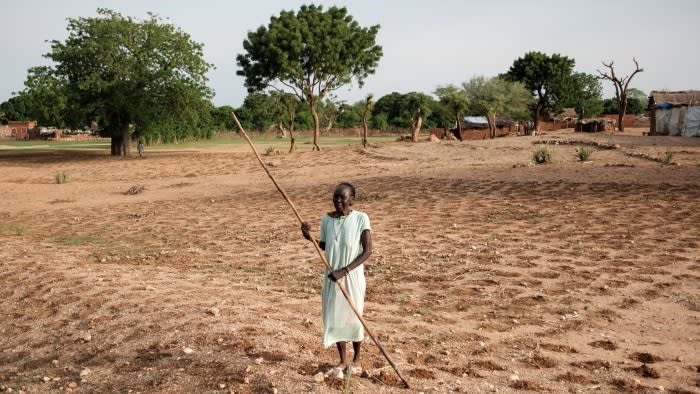Our Terms & Conditions | Our Privacy Policy
Poor nations are choking on debt — we must grasp the solutions
Stay informed with free updates
Simply sign up to the Global Economy myFT Digest — delivered directly to your inbox.
The author is an FT contributing editor and writes the Chartbook newsletter
Economic policy today is stalked by the prospect that the triumphant march of globalisation will give way to geopolitical fragmentation. But scenarios of “slowbalisation” — or even partial deglobalisation — pale in comparison with the fact that a large part of the most rapidly growing population on the planet, in sub-Saharan Africa, has not yet partaken in the global growth story.
Hundreds of millions of people experience an exclusion of a more elementary and devastating kind than any protectionist tariff or tech sanction. They lack the means to join the world economy on anything other than abject terms.
As the most recent poverty report of the World Bank makes clear, as much of the world has grown to middle income status, extreme poverty has become concentrated in failed and fragile states, above all in sub-Saharan Africa. There, a population of 1.2bn — some 15 per cent of the world’s population — gets by with an average GDP per capita that is a fifth of the global average. Hundreds of millions are consigned to scraping a living in the informal sector in sprawling slum cities, or as peasant farmers. At worst, what threatens is famine, as seen today in Sudan.
By 2050 UN data suggests that Africa’s population of 2.5bn will account for 25 per cent of the world’s working-age individuals, and yet many of those young people will grow up in societies unable to offer them even basic education and infrastructure. As the World Bank warns, political conflicts, geopolitical entanglements and environmental damage threaten to compound the polycrisis.
Without investment there can be no escape from this poverty trap. But investment is blocked by political instability and lack of funding.
It wasn’t supposed to be like this. Following the debt forgiveness campaign of the early 2000s, the 2010s saw a wave of optimism. The search for yield on the part of rich-world lenders, coupled with increasingly sophisticated financial institutions in the developing world, meant that low-income countries became significant borrowers in private capital markets.
That brightened the prospects for investment, but also exposed fragile economies to global interest rate fluctuations. While we were in a world of low rates, the flow of funds continued. Chinese lending piled on top. But, in the aftermath of the Covid-19 pandemic, new debt issuance came to a sudden stop. In 2022, there was a net drain to the tune of $16bn. Of late, the main function of the IMF and World Bank has been to fund exits by private sector lenders and Chinese banks. Today 770mn Africans live in countries where interest payments exceed spending on basic healthcare.
To move forward with new investment and new funding, there must be a reckoning with the financial legacy of the last 20 years.
Since 2020, the G20 has instituted the so-called Common Framework that is notionally designed to include the restructuring of the complex mesh of bilateral public and commercial debts. Unfortunately, it is not working with anything like the speed that is needed. To overcome this roadblock, two teams of experts are now making urgent calls for action.
The so-called Bridge proposals from the Finance for Development Lab, which is endorsed among others by Joe Stiglitz, argues for triage. Forcing all economies in difficulty to restructure serves to spread stigma. Some 20 to 30 developing countries that are having difficulty refinancing their debts are in temporary rather than fundamental difficulties. They need a bridge facility that enables them to defer payments until conditions improve and they can resume the existing model of private lending and borrowing.
The DRGR proposal advanced by a global coalition of development experts takes a more radical approach. They start from the premise that the current situation is too serious to be patched up. As after the Latin American debt crisis of the 1980s, we need to draw a line.
The hardest hit debtor economies in Africa need comprehensive debt relief, with the haircut for creditors coming to $90bn-100bn. In a break from precedent, the DRGR experts recommend that the IMF and the World Bank should also accept haircuts. Damage to their balance sheets should be made good by fresh capital injections. Private lenders would be induced to swap their outstanding claims for tradeable Brady bonds with environmental linkages and partial public guarantees.
Though different in approach, the two proposals share a sense of urgency and complement each other. The short-term Bridge idea opens the path to the more thoroughgoing restructuring advocated by DRGR. As a matter of urgency, the G20 should take up both proposals and back them with real financial muscle.
Until we begin to question the “normality” of the fact that, over the course of the business cycle, a billion people can be cut out of global capital markets, we are not addressing the most consequential risks of the economic fragmentation that characterises our world today.
Images are for reference only.Images and contents gathered automatic from google or 3rd party sources.All rights on the images and contents are with their legal original owners.



Comments are closed.